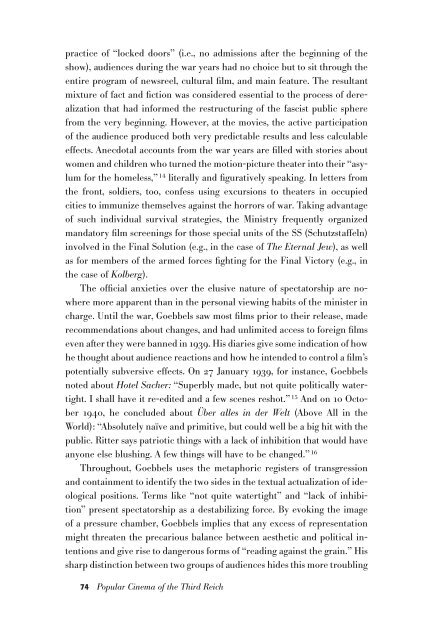Create successful ePaper yourself
Turn your PDF publications into a flip-book with our unique Google optimized e-Paper software.
practice of “locked doors” (i.e., no admissions after the beginning of the<br />
show), audiences during the war years had no choice but to sit through the<br />
entire program of newsreel, cultural film, and main feature. The resultant<br />
mixture of fact and fiction was considered essential to the process of derealization<br />
that had informed the restructuring of the fascist public sphere<br />
from the very beginning. However, at the movies, the active participation<br />
of the audience produced both very predictable results and less calculable<br />
effects. Anecdotal accounts from the war years are filled with stories about<br />
women and children who turned the motion-picture theater into their “asylum<br />
for the homeless,” 14 literally and figuratively speaking. In letters from<br />
the front, soldiers, too, confess using excursions to theaters in occupied<br />
cities to immunize themselves against the horrors of war. Taking advantage<br />
of such individual survival strategies, the Ministry frequently organized<br />
mandatory film screenings for those special units of the SS (Schutzstaffeln)<br />
involved in the Final Solution (e.g., in the case of The Eternal Jew), as well<br />
as for members of the armed forces fighting for the Final Victory (e.g., in<br />
the case of Kolberg).<br />
The official anxieties over the elusive nature of spectatorship are nowhere<br />
more apparent than in the personal viewing habits of the minister in<br />
charge. Until the war, Goebbels saw most films prior to their release, made<br />
recommendations about changes, and had unlimited access to foreign films<br />
even after they were banned in 1939. His diaries give some indication of how<br />
he thought about audience reactions and how he intended to control a film’s<br />
potentially subversive effects. On 27 January 1939, for instance, Goebbels<br />
noted about Hotel Sacher: “Superbly made, but not quite politically watertight.<br />
I shall have it re-edited and a few scenes reshot.” 15 And on 10 October<br />
1940, he concluded about Über alles in der Welt (Above All in the<br />
World): “Absolutely naïve and primitive, but could well be a big hit with the<br />
public. Ritter says patriotic things with a lack of inhibition that would have<br />
anyone else blushing. A few things will have to be changed.” 16<br />
Throughout, Goebbels uses the metaphoric registers of transgression<br />
and containment to identify the two sides in the textual actualization of ideological<br />
positions. Terms like “not quite watertight” and “lack of inhibition”<br />
present spectatorship as a destabilizing force. By evoking the image<br />
of a pressure chamber, Goebbels implies that any excess of representation<br />
might threaten the precarious balance between aesthetic and political intentions<br />
and give rise to dangerous forms of “reading against the grain.” His<br />
sharp distinction between two groups of audiences hides this more troubling<br />
74 Popular Cinema of the Third Reich

















